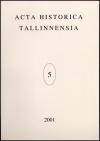Rahvusvahelise Tööorganisatsiooni (ILO) meretööd reguleerivate konventsioonide ratifitseerimisest Eestis aastail 1920–1940
International Maritime Labour Standards and their Ratification by Estonia in 1920–1940
Author(s): Maie PihlamägiSubject(s): Labor relations, Government/Political systems, International relations/trade, Interwar Period (1920 - 1939), Globalization
Published by: Teaduste Akadeemia Kirjastus
Summary/Abstract: This article examines how Estonia as a member of the International Labour Organization (ILO) fulfilled its international obligation to ratify the ILO maritime labour conventions and guarantee adequate working conditions and social protection against unemployment, work injury and illness for Estonian seafarers between the two world wars.In the first years of Estonia’s independence the maritime labour relations were virtually unregulated if we do not take into account a number of provisions of the obsolete tsarist Commercial Code inherited by Estonia. The ILO maritime standards adopted by the international labour conferences affected not only the improvement of Estonian seamen’s working conditions, but also gave an impetus to the development of maritime law in Estonia. Since 1921, when Estonia became a member of the International Labour Organization, the representatives of the Estonian government, employers and workers took part in the ILO annual conferences in Geneva. There they met delegates from other member states, exchanged information and opinions, discussed and debated on various policies and got fresh ideas for the development of labour relations in the maritime industry.The attitude of Estonia with regard to International Labour Standards was positive. In the 1920s Estonia adopted nine of the ten International Maritime Conventions fixing the minimum age for the admission of children to employment at sea, establishing employment agencies for seamen, requirements for seafarers’ employment contracts, compulsory medical examination of young seafarers etc. Harmonization of the Estonian seamen’s working conditions with the other seafaring nations was very important due to the increasing globalization of shipping. By filling in questionnaires of the International Labour Office on issues of the planned labour standards the member states, including Estonia, contributed to the promotion of the international labour standards. On the other hand, the ratification of international labour standards and implementation of their provisions helped to increase the influence of the ILO.In the 1930s Estonia ratified only one of the seven ILO maritime labour standards negotiated and adopted in the conferences of the ILO. It was the convention on competency requirements for ship management, which was very important to ensure safety of navigation. However, Estonia did not ratify the standards guaranteeing for seafarers the protection in case of sickness, work injury, paid holiday and 8-hour working day. The most important reason for that was the Great Depression of the 1930s. In the post-crisis years not only Estonia but also other countries were not eager to take new obligations. Because of the lack of the new investments, the Estonian ship owners resisted the ratification of new maritime labour standards because the government put all the costs connected with the implementation of standards on their shoulders. However, besides the economic burden the selective ratification of standards was also due to the strong socio-economic influence of employers in Estonia.Between the two world wars the Estonian Parliament ratified 10 of the 17 ILO maritime labour conventions, slightly over half of the conventions. However, the effect of the ILO standards cannot be seen only in the number of ratified conventions. Even though Estonia did not ratify all the conventions, the Estonian seafarers benefitted from the ILO international labour standards because a considerable number of the requirements were included into national legal acts. It was also important that the conventions were discussed and openly disputed, which allowed policy-makers to evaluate the expectations of the interested parties.
Journal: Acta Historica Tallinnensia
- Issue Year: 2016
- Issue No: 22
- Page Range: 67-88
- Page Count: 22
- Language: Estonian

